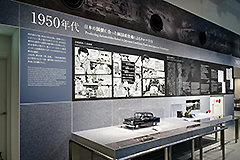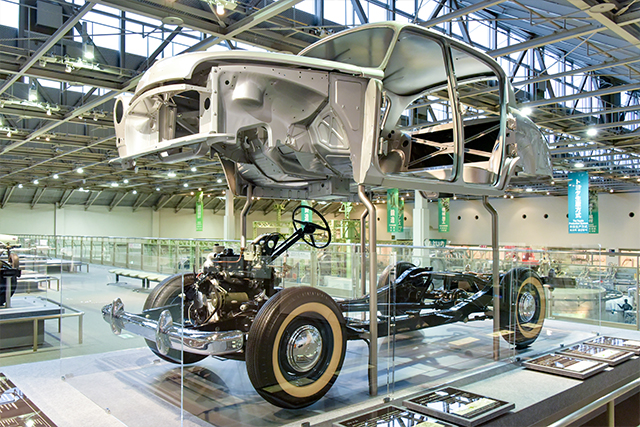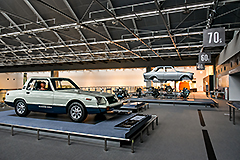Automobile Development Through the Decades
This section showcases, decade by decade, the automotive development challenges embraced by Toyota in its quest to meet the needs of its customers and the demands of society, and the ways in which its Making Things (“Monozukuri”) philosophies have led to the Toyota of today.
The 1950s
─Creating Cars Using “Pure Japanese” Technology to Match the Japan of the 1950s─

Although Toyota was saved from bankruptcy in the post-World War II economic recession thanks to special wartime demand from Korea, the death of its founder, Kiichiro Toyota, immediately posed another major crisis. His last wish, that his employees would “use our own heads and hands to build cars for the people,” was taken on by his subordinates.
The strategy, implemented thus far, of “collecting technology” to develop automobiles, in addition to market research performed to understand customer needs, resulted in the development of the Crown, released in 1955.

The 1960s
Creating Cars for the Public with World-Class Performance and Quality

In 1964, Toyota began the development of its first-ever automobile targeted at overseas markets. With an emphasis on the high-speed performance needed for driving on American expressways, car sizes were increasing well past the dimensions of a typical Japanese taxi. Developed as an international product featuring a “speedy” external design, the RT40 Corona achieved distinction by successfully completing a 100,000-kilometer test drive on the Meishin Expressway and went on to enjoy huge popularity both in Japan and abroad.
In addition, the new Corolla was launched in 1966. Its development included goals of 80 points or more in areas such as cost efficiency, performance and comfort of ride, with sportiness as an additional goal. Earning a reputation as “a car you can be proud to own and one you’ll never tire of driving,” it achieved great popularity among people who had dreamed of owning their own car, becoming a best seller in domestic and international markets.

The 1970s
Creating Cars to Address a Variety of Social Issues

A rapid increase in automobile ownership brought with it problems such as increased traffic accidents and air pollution and, together with the oil crisis that was also occurring at the time, presented a set of social issues that required changes in automobile manufacturing to address. Toyota joined the United States government’s “ESV” (Experimental Safety Vehicle) program calling for the development of safer vehicles, developing the Toyota ESV, which was designed to provide improved protection to occupants in collisions and to improve emergency vehicle avoidance. Some of these technologies were then put to use in the fifth-generation Corona (the RT100), which went on the market immediately afterward.
The company began to address air quality issues by ensuring compliance with ever-more-stringent regulations, improving its combustion processes and using catalytic converters for cleaner exhaust gases. To meet the requirements imposed by the 1978 regulations, said to be the strictest in the world, the full power of the Toyota Group was focused on the development of a three-way catalytic converter, oxygen sensors and an EFI (electronic fuel injection system), which today is still one of the world’s main exhaust purification systems.
For increased power efficiency, the engine itself was improved to reduce fuel consumption and the weight of the vehicle itself was reduced as well. 1978 saw the launch of the Tercel/Corsa, the first line of front-wheel-drive cars from Toyota.
The 1980s
Creating Cars to Address Increasingly Diverse Customer Needs

Throughout the 1980s, automobile sales in Japan continued to soar. In overseas markets, the highly fuel-efficient Japanese cars gained in popularity and were exported in greater and greater numbers, leading to instances of trade friction. As a result, Toyota and other Japanese automobile manufacturers began full-scale overseas production efforts to avoid having to restrict their export volumes.
In the Japanese market, meanwhile, a diversifying set of consumer needs let Toyota to launch a string of new models. Engines were revamped to offer improved performance and fuel efficiency.
This was also the era in which Toyota first embraced the challenge of developing a new luxury automobile. Research into the type of luxury car desired by the expanding North American “yuppie” demographic led to the creation of the new, uncompromising development concept that became the LS400, which became the flagship model of the new “Lexus” luxury brand in 1989.
The 1990s and Beyond
Creating Environmentally-Friendly and Safe Cars

With continued increases in vehicle sales and in the number of licensed drivers throughout the 1980s, the number of traffic accident-related deaths passed 10,000 in 1988, giving rise to a need for further improvements in automobile safety. Toyota developed and deployed “Preventative Safety Technology,” featuring sophisticated vehicle control systems utilizing advanced electronic technology to avoid collisions before they occur. In addition, collision safety technology was reworked beginning with chassis design, and a new body type, with a standard known as GOA (Global Outstanding Assessment), was developed with the goal of delivering best-in-class safety and, along with seatbelts and airbags, saw wide distribution.
In 1997, in response to increasing global recognition of environmental issues, Toyota launched the Prius, the world’s first mass-produced hybrid passenger car, which featured double the fuel efficiency in order to cut CO2 emissions in half.
With the philosophy that “eco-friendly cars must be widely adopted in order to help the environment,” the development of eco-friendly vehicles continued, with 2012 seeing the launch of the PRIUS PHV, featuring at-home charging capability and an extended electric drive range, and 2014 seeing the launch of the Mirai, the world’s first hydrogen fuel cell-based sedan, known as an “extremely eco-friendly car” and featuring water-only exhaust during operation.

